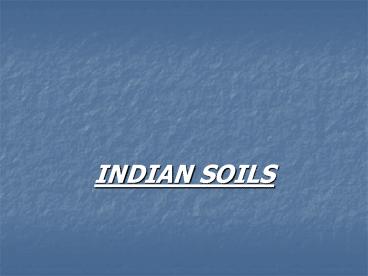INDIAN SOILS - PowerPoint PPT Presentation
1 / 14
Title: INDIAN SOILS
1
- INDIAN SOILS
2
(No Transcript)
3
TYPES OF SOILS
- .ALLUVIAL SOILS
- .BLACK SOILS
- .RED SOILS
- .LATERITE SOILS
- .DESERT SOILS
- .MOUNTAION SOILS
- .SAILNE ALKALINE SOILS
- .PEATY MARSHY SOILS
4
ALLUVIAL SOILS
- Formed by deposition of alluvium by rivers.
- Occupies 15 lakh Sqkm area in india.
- Contribute greatly in agricultural development.
- Characteristics Transported soils.
- Corsers in upper section and finest in
- delta.
- Light to dark in colours.
- Rich in Phoshorus and Nitrogen.
- Hilghly fertile, good for all crops ( Kharif
Rabi ) - CROPS- Rice,Wheat, Sugarcane, Cotton ,Jute.
- ARCES- Punjab, Harynana, U.P., Bihar, W.B. ,Assam.
5
BLACK SOIL
- Also known as REGURE OR Black cotton soli.
- Dark grey to Black in colour.
- High clay content.
- Highly moinst retentive.
- Develpos creacks in summer.
- Covers 5.4 lakh sqkm.
- Highly suitable for cotton rich in iron, lime,
calcium,magnesium ,carbonates, alumina. - Poor in phosphorsres, Nitrogen Organic matter.
- CROPS- Cotton, Sugarcane, Ground nut, millets
Rice, Wheat, Oilseads. - AREAS- Maharastra, Karntaka, T.M. Rajasthan.
6
RED SOILS
- More sandy less clayes.
- Formed due to weathering of old crystalline
rocks. - Rich in iron ,small amount of Humus.
- Poor in phosphous, Nitrogen lime.
- Slightly acidic and do not retain moisture.
- 3.5 lakhs sqkm.area.
- Porous and Frible.
- AREA- Tamil Nadu,Southern Karnataka parts, West
Bengal , Maharashtra. - CROPS- Groundnut, milletr, potato, rice,
wheat,sugarecane.
7
LATERITE SOIL
- Latin word meaning brick.
- Formed under high temperature and rain fall with
wet and dry spell. - Silic a is leached due to high rainfall.
- Remnants of iron and aluminumm oxides leaft
behind is known as laterrite. - Brown to yellowish colour.
- Becomes hard when exposed to atmossphere.
- Used asbuilding material.
- Rich in iron.
- Poor in line, potaash and magesium.
- Occupies 2.4 lakh sqkm.
- AREAS- Parts of assam, Karnatka, T.N,.
- Crops- Tea ,Coffee, Cashew, Rubber and Coconut.
8
DESERT SOIL
- Contanis soluble salts.
- Originated by mechanical disintegration wind
deposit. - Prous and Coarse.
- Rich in Nitrates Phossphates.
- Poor in Nitrogen Humus.
- Friable, sanday low moist content.
- 1.4 lakhs sqkm.
- AREAS- Arid semi arid regions of
Rajasthan,Haryana, Punjab. - CROPS Droughnt registant crops like millets and
barey.
9
MOUNTION SOIL
- Found in hill slopes
- Formed by deposition of organic.
- Rich in humanus.
- Door in potash and line.
- AREAS- Assam, Kashmir, Sikkim Arunachal
Pradesh. - CROPOS- Tea, Coffee, Spices Tropical fruits..
10
SALINE ALKALINE SOIL
- Contains salts like sodium, magnesium calcuim.
- Infrtile ,unfit for cultivation.
- Sanday to loamy intexture.
- AREAS- Parts of Gujarat, Rajasthan.
Punjab,Haryana, U.P, Maharashtra.
11
PEATY MARSHY SOIL
- Occurin humind region.
- Formed by accumulation of organic matter.
- Black in colour.
- Highly acidic and heavy.
- AREAS- Kerala, Orrissa, Sundarbans of W.B.
12
SOIL EROSION
- Removal of top soil by different agents.
- CAUSES
- Deforestion
- Overgrazing
- Faulty method of Agriculutre.
- Ersion by rivers.
- Removal of top soil.
- Shifting cultivation.
13
SOIL EFFECTS
- Loss of cultivable land.
- Reducation in siol feritility.
- Causesliting may change river course.
- Results in lots of run off.
- Reduces percolation of ground water.
14
SOIL CONSERVATION
- Protection of soil from Erosion Deterioration.
- Measures for soil conservation
- Contour farming.
- Mulching ( spreading of grass,
- leaves on
ground) - Afforestion and Reforestion.
- Controlled of dams barrages
cropo - rotation.
- Subsoiling.
- Terrace farming.































